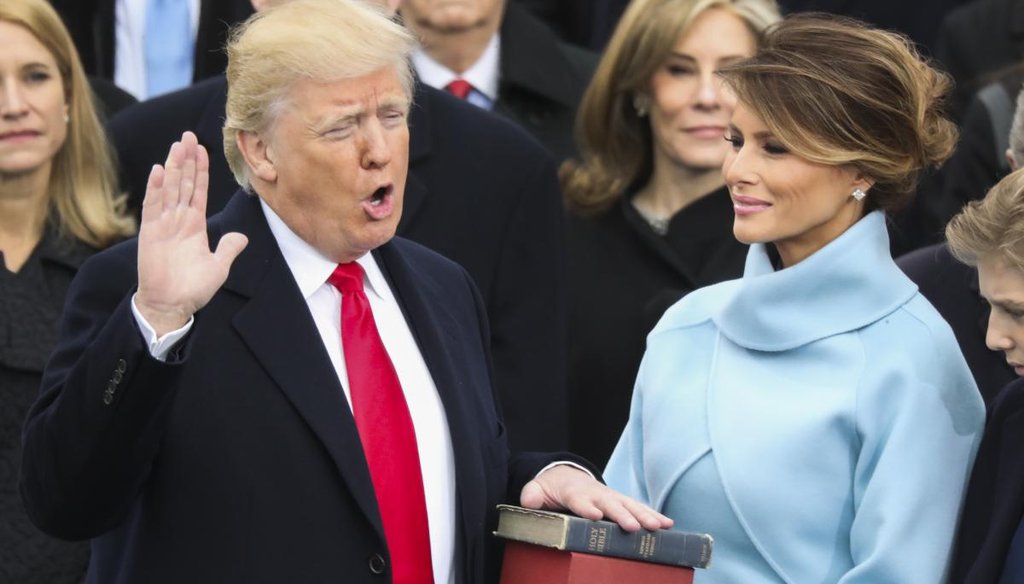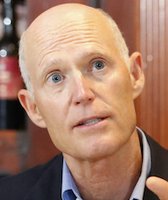Get PolitiFact in your inbox.

Donald Trump is sworn in as the 45th president of the United States. (AP)
President-elect Donald Trump promised coal jobs in West Virginia and manufacturing jobs in Michigan. He said he would fix the inner city of Baltimore and the airports in New York. He said he would cut taxes and grow the military. Create paid family leave and balance the budget.
Build the wall. Kill Obamacare.
Protect Social Security. Take care of veterans.
And that’s just the start.
"We’re going to win so much, you’re going to be so sick and tired of winning, you’re going to come to me and go ‘Please, please, we can’t win anymore.’ … You’ll say ‘Please, Mr. President, we beg you sir, we don’t want to win anymore. It’s too much. It’s not fair to everybody else,’ " Trump said in Montana last May. "And I’m going to say ‘I’m sorry, but we’re going to keep winning, winning, winning. We’re going to make America great again.’ "
The pitch worked. Now comes the hard part: Can Trump deliver?
For the past six months, PolitiFact has been cataloging promises Trump made to voters in speeches, appearances, interviews and debates. Today we launch our Trump-O-Meter, which will track 102 of the most significant pledges emblematic of his unconventional campaign. The Trump-O-Meter will measure whether Trump is able to accomplish what he told voters and ultimately rate each promise Kept, Broken or Compromise. It’s the same process we used to track the campaign promises made by President Barack Obama.
While Obama’s promises often were hyper-specific (e.g., "Better integrate efforts of federal agencies with the military through new Mobile Development Teams"), Trump’s are sweeping.
That brings additional challenges.
"An unsuccessful foreign or military engagement, a natural disaster, failed diplomacy, a spike in gas prices, a stock market crisis or any of the other factors that bedevil every president can easily befall Trump," said veteran Republican strategist Rick Wilson, who opposed Trump during the campaign. "These are externalities that no amount of bluster, tweeting and red hats immunize a president against."
The 102 promises we’re watching account for the major tenets of Trump’s tax and immigration plans, his ideas to repeal and replace Obamacare and his proposals to shift American trade policy. Plenty of his ideas will find opposition from the Republican-controlled Congress. In some cases, Trump’s promises will be difficult to keep.
Yet Trump has guaranteed results and promised swift action. On his first day in office, Trump has vowed to withdraw from the Trans-Pacific Partnership trade agreement, eliminate gun-free zones, rescind executive orders on guns and immigration, cancel federal funding to sanctuary cities, start work on the border wall, begin deporting undocumented immigrants with criminal records, suspend immigration from terror-prone countries and ask Congress to repeal the Affordable Care Act.
Beyond that, he has promised to fix America’s inner cities, double America’s rate of economic growth, put millions of people to work and rebuild the country’s highways, bridges, tunnels, airports, schools and hospitals.
To conservative National Review columnist Jonah Goldberg, it’s "unicorns as far as the eye can see."
"He essentially vowed that we could rewind the movie of the last 50 years. Lost jobs would come flying back like the pieces of a shattered vase reassembling as the video plays in reverse," Goldberg wrote. "That won’t happen. It won’t happen because Trump must now deal with the tools and materials of the real world."
Deciphering Trump’s rhetoric
There’s a difficulty in tracking Trump’s promises because his words can be contradictory or unclear.
Take his promise to ban Muslims from entering the country. In the weeks before the Iowa caucus, Trump pledged that he would halt all Muslim immigration to the United States. But during the general election, Trump said he would ban immigration from regions with a history of terrorism.
Both ideas remain on his website, so we decided to track both promises.
Likewise, at the start of the campaign, Trump said all 11 million people living in the country illegally "have to go." Later in the campaign, he focused on people living in the country illegally who have committed crimes.
Again, we will track both promises.
In coal country, Trump vowed to reverse a decades-long trend and put miners back to work. "Get ready because you’re going to be working your asses off," he said in West Virginia.
In the rust belt, he pledged manufacturing jobs.
How will he accomplish either? Details are slim. Trump has said he plans to unleash the American economy by creating an environment better for business. That means lower tax rates and fewer regulations. Trump promises that before any new regulation is approved, two will be rescinded.
Dan Mitchell, an economist with the libertarian Cato Institute, says the proposals will make the United States more attractive to businesses. But, on the specifics, experts say it will be hard for Trump to meet the letter of his word. We spoke with eight economists. None predicted a major spike in new manufacturing or mining jobs.
"It is not even remotely possible that Trump will be able to bring back employment in coal or total manufacturing back anywhere near the level of the mid-20th century. Not even in absolute numbers, let alone as a percentage of total employment," said Jeffrey Frankel, a Harvard University government and economics professor who served on President Bill Clinton’s Council of Economic Advisers. "It's no more feasible than bringing agricultural employment back to 1790, when farmers were 90 percent of national employment vs. 2 percent today."
Coal’s problems, in particular, have to do as much with the increased availability of natural gas through fracking as anything, experts say.
"The only way to bring back any jobs would be to outlaw fracking, since the biggest problem in the last few years for the industry has been the availability of cheap natural gas," said Dean Baker, an economist with the liberal Center for Economic and Policy Research. "Of course even then, we would only get back a small share of the coal mining jobs lost in the last three decades."
The cost of the wall, and who’s footing the bill
The 102 promises we’re analyzing on the Trump-O-Meter include promises Trump already has indicated he won’t keep, including his vow to appoint a special prosecutor to investigate Hillary Clinton.
Trump told a crowd in California in June that if he won his "attorney general will take a very good look" at Clinton’s case. In August, in Ohio, Trump said Clinton’s case "required" a special prosecutor. At the second presidential debate in St. Louis, Trump said he would "instruct my attorney general to get a special prosecutor to look into" Clinton’s situation. And the next day, in Pennsylvania, he said, "Special prosecutor, here we come."
But Trump told the New York Times after the election that he doesn’t "want to hurt the Clintons, I really don’t."
We will still track the promise, however, because it is something Trump promised voters ahead of Election Day.
The Trump-O-Meter also will track Trump’s signature pledge to build a wall along the U.S.-Mexico border. The question is who will pay and when.
Trump said the wall would either cost $8 billion or $12 billion. He said it would be 35 to 40 feet, or 50 feet, or higher.
Without precise plans, it’s hard to determine how much it would cost. Fencing, hardly a great "impenetrable and beautiful" wall, may cost at least $5.1 billion. Some estimates stretch to $25 billion.
The "build the wall!" chants also skipped past the fine print in his plan -- that Mexico would be asked to reimburse the United States for the cost to build the wall. Until then, the bill appears headed to the American taxpayer.
At odds, long odds
Trump promised to reinstate waterboarding, a controversial interrogation technique that simulates drowning and is considered torture, even though his own pick to lead the Department of Defense, retired Gen. James Mattis, says beer and cigarettes are more effective methods of extracting information.
He vowed to move the U.S. embassy in Israel to Jerusalem, though other presidents have broken the same promise in hopes it could save Middle East peace talks.
Trump claimed in an interview with Bob Woodward that he would eliminate the $19 trillion federal debt within eight years, even though experts say his economic plan would actually increase the debt by trillions.
He promised to adopt the "penny plan" to reduce non-defense, non-entitlement spending by 1 percent per year, though he also has said he would spend at least $550 billion improving America’s infrastructure system.
PolitiFact has been tracking the promises of presidents, governors and mayors for nearly nine years, and no one has achieved everything pledged to voters.
Nearly one-in-four of Obama’s campaign promises, for instance, ended up broken, according to our Obameter. In some cases, new events necessitated a change in priority. In others, Congress got in the way.
"We care about politicians keeping their promises for a couple of reasons, but one is that reputation is currency in politics: If someone won't or can't do what he says he would, he will be trusted less the next time he makes a promise," said Timothy Hill, a political science professor at Doane College in Nebraska who has written about presidential promises. "But, to this point, anyway, that law of gravity seems to be suspended around Donald Trump. His campaign was always about attitude, not substance, and the post-election period has been no different."
What he can do, where he needs help
The Trump-O-Meter will rate outcomes, not intentions, the same standard we used for Obama. So it’s not enough for Trump to propose, as he has, six weeks of paid family leave for new mothers. It’s up to him see the legislation through the Republican-led Congress.
Some promises Trump can pursue unilaterally.
He can keep the prison facility in Guantanamo Bay, Cuba, operating without lifting a finger, and he can force a move of the U.S. embassy in Israel to Jerusalem. Trump already has celebrated a campaign promise to keep a Carrier air conditioning factory open in Indiana (though jobs are still moving to Mexico).
Trump also has promised to issue an executive order mandating the death penalty for anyone convicted of killing a cop. He has the ability to issue the order, but presidents do not have the authority to create penal laws, experts say. That requires Congress. "There would have to be a law passed by Congress under any ordinary understanding of the power of the different branches," said Sheri Johnson, a law professor at Cornell University.
And in the case of the death penalty, the Supreme Court ruled that mandatory death penalty sentences are unconstitutional.
But in many cases, Trump will find himself in an unfamiliar position as the CEO-turned-president: at the mercy of others.
Trump’s tax plan, a simplifying of the tax code and lower rates for many but not all, needs the support of Congress. He is likely to have a willing partner.
Trump’s dream of congressional term limits requires an amendment to the Constitution. That means the approval of two-thirds of the House and Senate and the ratification of 38 state legislatures. The last amendment to the Constitution, dealing with congressional pay, took 202 years to ratify.
Trump told voters during the campaign he would "make every dream you ever dreamed for your country come true."
Starting Friday, we’ll find out.
Our Sources
Listed in the story.

















































